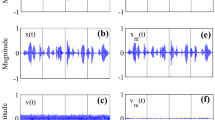Access this book
Other ways to access
About this book
As speech processing devices like mobile phones, voice controlled devices, and hearing aids have increased in popularity, people expect them to work anywhere and at any time without user intervention. However, the presence of acoustical disturbances limits the use of these applications, degrades their performance, or causes the user difficulties in understanding the conversation or appreciating the device. A common way to reduce the effects of such disturbances is through the use of single-microphone noise reduction algorithms for speech enhancement. The field of single-microphone noise reduction for speech enhancement comprises a history of more than 30 years of research. In this survey, we wish to demonstrate the significant advances that have been made during the last decade in the field of discrete Fourier transform domain-based single-channel noise reduction for speech enhancement.Furthermore, our goal is to provide a concise description of a state-of-the-art speech enhancement system, and demonstrate the relative importance of the various building blocks of such a system. This allows the non-expert DSP practitioner to judge the relevance of each building block and to implement a close-to-optimal enhancement system for the particular application at hand. Table of Contents: Introduction / Single Channel Speech Enhancement: General Principles / DFT-Based Speech Enhancement Methods: Signal Model and Notation / Speech DFT Estimators / Speech Presence Probability Estimation / Noise PSD Estimation / Speech PSD Estimation / Performance Evaluation Methods / Simulation Experiments with Single-Channel Enhancement Systems / Future Directions
About the authors
Dr. ir. Richard C. Hendriks obtained his M.Sc. and Ph. D. degrees (both cum laude) in electrical engineering from Delft University of Technology, Delft, The Netherlands, in 2003 and 2008, respectively. From 2003 till 2007 he was a Ph.D. researcher at Delft University of Technology, Delft, The Netherlands. From 2007 till 2010 he was a postdoctoral researcher at Delft University of Technology. Since 2010 he is an assistant professor in the Signal and Information Processing Lab of the faculty of Electrical Engineering, Mathematics and Computer Science at Delft University of Technology. In the autumn of 2005, he was a Visiting Researcher at the Institute of Communication Acoustics, Ruhr-University Bochum, Bochum, Germany. From March 2008 till March 2009 he was a visiting researcher at Oticon A/S, Copenhagen, Denmark. His main research interests are digital speech and audio processing, including single-channel and multi-channel acoustical noise reduction, speech enhancement and intelligibility improvement.Prof. Dr.-Ing. Timo Gerkmann studied electrical engineering at the universities of Bremen and Bochum, Germany. He received his Dipl.-Ing. degree in 2004 and his Dr.-Ing. degree in 2010 both at the Institute of Communication Acoustics (IKA) at the Ruhr- Universitat Bochum, Bochum, Germany. From January 2005 to July 2005 he was with Siemens Corporate Research in Princeton, NJ, USA. In 2011 he was a postdoctoral researcher at the Sound and Image Processing Lab at the Royal Institute of Technology (KTH), Stockholm, Sweden. Since December 2011 he heads the Speech Signal Processing Group at the Universitat Oldenburg, Oldenburg, Germany. His main research interests are on speech enhancement algorithms and modeling of speech signals.
Jesper Jensen received the M.Sc. degree in electrical engineering and the Ph.D. degree in signal processing from Aalborg University, Aalborg, Denmark, in 1996 and 2000, respectively. From 1996 to 2000, he was with the Center for Person Kommunikation (CPK), Aalborg University, as a Ph.D. student and Assistant Research Professor. From 2000 to 2007, he was a Post-Doctoral Researcher and Assistant Professor with Delft University of Technology, Delft, The Netherlands, and an External Associate Professor with Aalborg University. Currently, he is a Senior Researcher with Oticon A/S, Copenhagen, Denmark, where his main responsibility is scouting and development of new signal processing concepts for hearing aid applications. He is also a Professor with the Section for Multimedia Information and Signal Processing (MISP), Department of Electronic Systems at Aalborg University, Denmark. His main interests are in the area of acoustic signal processing, including signal retrieval from noisy observations, coding, speech and audio modification and synthesis, intelligibility enhancement of speech signals, signal processing for hearing aid applications, and perceptual aspects of signal processing.




